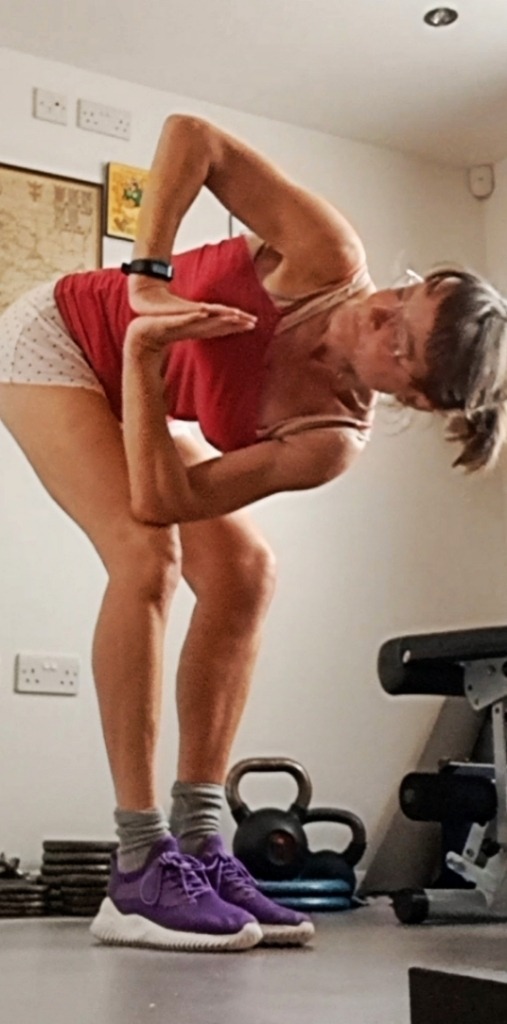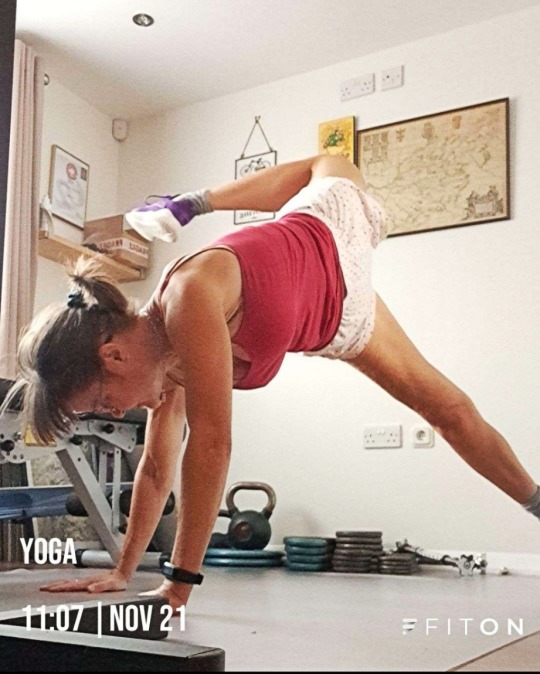#yoga poses for diabetes
Explore tagged Tumblr posts
Text

Yoga Asanas for Managing Diabetes
The most powerful tools in managing diabetes is Yoga. Yoga is good for the entire body, improving muscular strength and endurance, balance and flexibility, and releasing stress.
Here is a list of the top ten asanas: https://www.freedomfromdiabetes.org/blog/post/top-10-yoga-asanas-for-managing-diabetes/2611
#yoga for diabetes#yoga asanas for diabetes#yoga for diabetes type 2#yoga exercise for diabetes#yoga for diabetes control#yoga poses for diabetes#yoga for diabetes cure#yoga for diabetic patient#yoga and diabetes#diabetes and yoga benefits#yoga and type 2 diabetes#yoga for diabetes and cholesterol#yoga and pranayam for diabetes#yoga and diabetes research
0 notes
Text
Top 10 Yoga Asanas for Managing Diabetes
This article is originally published on Freedom from Diabetes website, available here. With the continuing spate of diabetes cases, doctors and patients alike search for new ways to tackle the disorder. A process for complete diabetes reversal that includes diet, exercise, and stress management to bring about a behavioral transformation that can help diabetics reverse their condition and sustain it.

And one of the most powerful tools in this process is Yoga. We can say Yoga is the best medicine for this. Daily practice of yoga and pranayama can help in many ways, such as reducing blood sugar levels, regulating blood pressure, and lowering the risk of heart problems. Also help in improving muscular strength and endurance, balance and flexibility, and releasing stress.
Yoga and diabetes:
The basic cause for diabetes is insulin resistance, a condition where the body either doesn’t produce sufficient insulin or is unable to use the insulin produced by the pancreas. Insulin resistance is responsible for a host of so-called ‘lifestyle disorders’, including, among others, BP, high cholesterol, PCOD/S, and of course, diabetes. Lets understand causes of insulin resistance, three are diet-related, two relate to exercise and one is, stress.
These poses activate your parasympathetic system, helping dissipate stress a key factor in fat storage. The poses also work on your visceral organs the pancreas, liver, kidney, in particular, all key organs in regulating blood sugar. Another area where these asanas have a major impact is the digestive tract. By improving blood flow to this area, the asanas help the body to maintain a healthy and balanced gut microbiome a key element in avoiding nutrient deficiency.
Here is a list of the top ten asanas, you should try and include in your daily practice
Surya Namaskar: Suryanamaskar improves blood circulation, improves spine health, increases muscular strength, lung capacity, and the management of insulin.
Padhastasana (hand under foot pose) - It stimulates your viscera and strengthens the abdomen, improving its efficiency.
Pavanamuktasana (wind removing pose)- This asana too has a great effect on your visceral organs, massaging the pancreas, liver, spleen, and colon
Shalabhasana (locust pose)- This exercises for your leg muscles tremendously.
Mandukasana (Frog Pose)- A powerful hip-opening movement, the mandukasana exerts pressure on the pancreas and liver.
Adho mukha svanasana- It relaxes your body, relieving stress. It is said to improve hearing, eyesight, and even hair growth!
Ardha Matsyendra Asana- It has a massaging effect on the pancreas, liver, and stomach, improving BSL management and digestion.
Bhujangasana (Cobra Pose)- The cobra pose brings many benefits, beyond the obvious one of spinal health
Santulanasana - This is a powerful strengthening pose for the arms, chest, back, triceps, leg, and core.
Butterfly pose - It improves posture, enhances spine health, and strengthens the muscles of the lower back, hips.
Yoga is not just a panacea, it is a lifestyle that brings many holistic benefits to the mind, body, and soul. Every asanas and pranayama technique brings its own special benefits.Yoga is one of the most cost-effective routines you can find, and you can practice it just about anywhere. To read more, click here. Also please connect with me on my website, Facebook page, and YouTube if you want to stay in touch or give me any feedback!
#yoga for diabetes#yoga asanas for diabetes#yoga for diabetes type 2#yoga exercise for diabetes#yoga for diabetes control#yoga poses for diabetes#yoga for diabetes cure#yoga for diabetic patient#yoga and diabetes#diabetes and yoga benefits#yoga and type 2 diabetes#yoga for diabetes and cholesterol#yoga and pranayam for diabetes#yoga and diabetes research
0 notes
Text
Yoga Poses for easing Diabetes | Life is Perfect
Strike a Pose to Ease Diabetes! 🧘♀️
Embrace this yoga posture to enhance your well-being and manage diabetes effectively.
Let's flow towards better health! 💪
Visit : Life is Perfect Rishikesh Join WhatsApp group for queries on +91- 8750685175 . . #yogaexercises#yogafordiabetes#yogadiabetes#yogaposesforbeginners#yogabenefits#yogaposestoday#yogabenefitslove#yogatraininginrishikesh#yogatrainingcourses#yogaandmeditation#yogateacher#healthylife#HealthierYou#JoinUsToday#lifeisperfect



#yoga poses#yoga pose for diabetes#physical and mental health in uttarakhand#yoga retreat in uttarakhand#naturopathy centres in uttarakhand#yoga and meditation schools in rishikesh#yoga benefits#yoga for diabetic patient#physical health#mental health
0 notes
Text
1/22/25
I got my A1C results back and the good news is that I'm not a diabetic!
The bad news is that my insurance company will not cover Zepbound unless I have sleep apnea. They do not cover ANY weight loss drugs. I will be doing a sleep study in a few days to see if i do have it. It's important to know whether or not I have it but I'm scared that I might because I snore super loud and a lot according to my fiance. He has a hard time getting to sleep if I fall asleep before him. I sincerely hope that I don't have it, but if I don't then I'll just go back to semaglutide. I'm determined to lose weight one way or another this damn year. 2025 is my year!
I had yoga tonight and my yoga teacher gave me the strangest and nicest compliment. She said my form was beautiful and that I should be a yoga teacher. She's always been super nice to me since I started but I don't know where this is coming from! I'm super flattered though. I know I could do certain poses better if I had a smaller stomach and if my legs were slimmer, but I do what I can. I've always been very flexible for my size so maybe that's it. I just thought that was such a nice thing to say. It brightened my day a little.
6 notes
·
View notes
Text
Best Exercises to Lower High Blood Sugar Levels Naturally
High blood sugar, or hyperglycemia, is a growing concern for millions of people worldwide. In the U.S. alone, around 34 million adults have diabetes, with many more living with prediabetes. The connection between exercise and blood sugar regulation is well-documented. Regular physical activity can boost insulin sensitivity and help manage glucose levels. Integrating exercise into a blood sugar management plan offers numerous health benefits, including improved mood, weight control, and enhanced energy levels.
Cardio for Blood Sugar Control
Aerobic Exercise Recommendations
Aerobic exercise is crucial for lowering blood sugar levels. The CDC and AHA recommend at least 150 minutes of moderate-intensity aerobic activity each week. This can include activities like brisk walking or moderate cycling. Aim for sessions that last at least 30 minutes most days.
Examples of Effective Cardio Workouts
Several cardio workouts can effectively manage blood sugar:
Swimming: A low-impact exercise that improves cardiovascular health.
Jogging: Ideal for burning calories and enhancing endurance.
Dancing: A fun way to engage muscles and elevate heart rate.
Real-life stories demonstrate success. For example, Sarah, a 45-year-old diagnosed with prediabetes, reported that regular swimming sessions helped normalize her blood sugar levels within months.
Monitoring Blood Sugar Before and After Cardio
Monitoring your blood sugar before and after workouts is essential. This helps you understand how your body responds to different exercises. If you notice a drop in your levels after exercise, consider having a snack rich in carbohydrates before your workout to prevent hypoglycemia.
Strength Training's Role in Blood Sugar Management
Building Muscle Mass and Insulin Sensitivity
Strength training boosts muscle mass, which improves insulin sensitivity. Research shows that increased muscle can enhance glucose uptake, making it easier for the body to manage blood sugar levels.
Recommended Strength Training Routine
A sample routine for beginners could include:
Bodyweight squats – 2 sets of 10-15 reps
Push-ups – 2 sets of 8-12 reps
Dumbbell rows – 2 sets of 8-10 reps
For advanced individuals, consider increasing weights and sets. Allow for 48 hours of rest between sessions for recovery.
Incorporating Strength Training into Your Week
Struggling to find time? Try scheduling 20 to 30 minutes, three times a week. Utilize shorter workouts and combine them with activities you already do. For instance, do a quick session during lunch breaks.
Yoga and Flexibility Exercises for Blood Sugar Balance
Yoga Poses for Improved Blood Flow and Circulation
Certain yoga poses can increase circulation and help regulate blood sugar:
Downward-Facing Dog: Strengthens and stretches your entire body.
Warrior Poses: Builds strength in the legs while enhancing focus.
Benefits of Mindfulness and Stress Reduction on Blood Sugar
Stress can lead to elevated cortisol levels, which can raise blood sugar. Research indicates that mindfulness practices, including yoga, may reduce stress and improve overall well-being.
Finding a Yoga Style That Suits You
Choose a yoga style that matches your fitness level. Gentle yoga is great for beginners, while Vinyasa offers more flow and movement. Joining a local class can provide motivation and guidance.
Walking: A Simple Yet Powerful Exercise
The Accessibility and Convenience of Walking
Walking is one of the easiest exercises to incorporate into daily life. It requires no special equipment, making it a fantastic choice for almost everyone.
Walking Strategies for Blood Sugar Control
Consider these walking strategies:
Take the stairs instead of the elevator.
Aim for a brisk pace, which enhances the benefits.
Explore walking routes that incorporate inclines to challenge yourself.
Combining Walking with Other Activities
You can easily combine walking with your regular tasks. Consider scheduling walking meetings or walking your dog when running errands.
Crucial Considerations for Exercise and Blood Sugar
Consulting Your Doctor Before Starting Any Exercise Program
Before beginning any exercise routine, consult your healthcare provider, especially if you have existing health concerns. They can help tailor a plan to your needs.
Adjusting Exercise Based on Blood Sugar Levels
Learn to gauge your pre-workout blood sugar levels. If levels are too low, consider a light snack prior to engaging in exercise. Adjust intensity based on how you feel.
Importance of Consistency and a Holistic Approach
Consistency is key in managing blood sugar. Coupling exercise with a balanced diet and medication (if necessary) is critical. Experts agree that lifestyle changes take time but have profound effects on health.
Conclusion
In summary, exercises like cardio, strength training, yoga, and walking can all play significant roles in managing high blood sugar. Always consult with a doctor before starting a new program and aim for consistency in your routine. Regular exercise not only aids in controlling blood sugar but also enhances overall health and well-being. Prioritize your physical activity; it’s crucial for a healthier future.
#diabetes#diabetescommunity#gestational diabetes#health and wellness#healthcare#type 1 diabetes#type 2 diabetes#wellnessjourney#north carolina#usa#health and fitness tips#health & fitness#health fitness#mens health and fitness#mental health#healthylifestyle#treatment#high blood sugar#diabetescare#insulin#diabetic#health#low blood sugar
4 notes
·
View notes
Text

•{Lemon Water & Sea Salt}•
Many of us have morning routines that are wonderful health practices — a morning meditation, a few yoga poses, a brisk walk around the neighborhood, or a delicious fruit-infused smoothie. Daily routines are vital to health and happiness, and this is especially true at the start of the day.
How about a quick and simple glass of warm lemon water with Himalayan salt? This simple drink can boost your morning health and wellness regimen — and it’s so easy to make. There are a number of professional athletes and Olympians who start their morning with lemon and salt water, which may say something about its effectiveness.
A 10-ounce glass of warm #lemon water with Himalayan salt in the morning can increase your immune function, decrease uric acid to fight inflammation, improve digestion, and balance your body. These benefits can be attributed to the vitamin C content of the lemon juice as well as the essential minerals contained in #Himalayansalt. This simple morning drink promotes vitality, health, and overall wellness, and may even improve your sex drive!
•Lemons are excellent for fighting inflammation. Lemons can help dissolve the uric acid in your joints, and also have been found to help build and repair tendons, ligaments, and bone. This anti-inflammatory property may be especially beneficial for people with rheumatoid arthritis and osteoarthritis, according to an American College of Physicians study on osteoarthritis, published in the Annals of Internal Medicine (2000).
•Aids in proper food and water absorption. A daily glass of lemon water with Himalayan salt may provide a better overall mineral balance, which promotes proper food and water absorption in your body, allowing essential nutrients to get where they need to be.
•Balances your body’s acidity (pH). The alkalizing effects of lemon and natural salt are highly useful for managing your body’s delicate pH balance, which is crucial for optimal functioning of the body’s systems.
•Boosts immune function. One lemon serves up 139 percent of your daily value (DV) for vitamin C. Squeezing one lemon into your morning is a natural alternative to that vitamin C supplement you may be taking.
•It’s a detox for your cells. The all-natural Himalayan salt mixed with lemon juice and water helps to pull toxins from your cells, reducing cellular toxicity. This may reduce your risk for various chronic diseases, as well as make you feel generally awesome!
•Reduces problematic cellulite. Natural salts like Himalayan salt have been used for centuries for skin care. Interestingly, most spa treatments for cellulitis contain some form of salt and/or citrus blend. A few daily gulps of lemon and salt water in the morning may firm up a few of those unsightly areas.
•Clears up skin and adds a fresh glow.Using natural salt for skin problems, such as psoriasis and eczema, dates back to ancient Roman times. Roman emperor Marcus Aurelius’ doctor, Galen from Pergamum, used sea salt for skin diseases, according to Science Tribune (1999).
•Useful for allergy season. It has been suggested that the combination of lemon and salt, specifically mixed into warm water, acts as a natural antihistamine for allergies. It may be the perfect alternative to those pink pills that leave you feeling drowsy.
•Paves the way for better sleep. The natural hormone-balancing properties of lemon and Himalayan salt can be more than useful when it comes to bedtime. Getting the proper amount of sleep is essential for physical health, mental health, productivity, and much more. This hormone-balancing beverage can make an effective nightcap.
•Helps controls blood sugar. The fiber content of lemons helps to balance blood glucose levels, which is useful for type 2 diabetes patients and prediabetics alike, according to a study published in the New England Journal of Medicine (2000).
•Lemons may help detoxify your liver.Vitamin C is essential for producing glutathione, which plays a foundational role in detoxifying the liver. It also has antiseptic properties that are useful for liver function, as well.
•Freshens breath! Lemon and Himalayan salt may not be the first things that come to mind when you think of fresh breath. However, the lemon and salt in this simple morning drink help kill the bad breath bacteria that build up while you’re sleeping.
•May help you chill out. When you get stressed out, do not be so quick to reach for those prescription pills. You may be able to chill out and return to that state of Zen by boosting your vitamin C levels first thing in the morning.
•Useful for reducing blood pressure.Lemons are not all about vitamin C and fiber. They also boast potassium, which is vital for flushing excessive sodium from the body.
•Boost your libido! The vitamin C content and hormone-balancing properties of this morning beverage can help lift your mood. This might be all it takes to boost your libido, without the need for that little blue pill.
•Gets you hydrated right out of the gate. Many people forget how important hydration is, especially after a seven or eight-hour sleep period with no water. Start your morning off right and get hydrated. The water, salt and zesty lemon will get your day off to the perfect start.
•An antioxidant powerhouse vital for, well, everything! Lemon offers up a wealth of vitamins and minerals, while Himalayan salt boosts your mineral and trace mineral levels even more. The antioxidant and detoxifying properties of lemon saltwater pack a powerful, free radical knockout punch.
•May improve your heart health.Lemons and real salt are both exceptional for increasing heart health on their own. However, when you combine the two into one vibrant morning drink, you get even more vital heart-thumping health benefits.
Natural salt supports electrochemical reactions in the body, while negative ions assist in healthy heart rhythm. Lemons are rich in vitamin C, which is, “associated with lower endothelial dysfunction in men with no history of cardiovascular disease or diabetes,” according to a study published in the American Journal of Clinical Nutrition (2006).
•Promotes digestive health. A glass of warm lemon water with Himalayan salt before breakfast, or any meal, helps signal your liver to produce the essential bile needed to clean out harmful gut bacteria. The fiber content and natural salt will also promote digestion.
Are you ready to commit to this simple and health-promoting morning drink? I have been drinking warm lemon water with a little bit of Himalayan salt every morning for months, and I absolutely love it. My energy levels are up, and I feel as cool as a cucumber throughout the day.
6 notes
·
View notes
Text
Role of Yoga and Meditation on Heart Health

In the fast-paced, stress-ridden world we live in today, maintaining cardiovascular wellness has become more crucial than ever. As we delve into the depths of this blog, we will explore the profound benefits that yoga and meditation can offer to support and enhance your heart health. To provide expert insights, we will also mention Dr. Amitabh Yaduvanshi, a renowned cardiologist at Holy Family Hospital, whose guidance has been instrumental in unraveling the mysteries of cardiac well-being.
Understanding Cardiovascular Wellness
Before we delve into the world of yoga and meditation, let's grasp the importance of cardiovascular wellness. Our heart, the ever-beating sentinel of life, pumps blood tirelessly, supplying oxygen and nutrients to every cell in our body. However, modern lifestyles characterized by sedentary routines, unhealthy eating habits, and chronic stress have put our hearts at risk. Cardiovascular diseases, including heart attacks and strokes, are leading causes of mortality worldwide.
To combat this alarming trend, individuals are increasingly turning to holistic approaches like yoga and meditation to nurture their cardiovascular health.
The Role of Yoga
Yoga is an ancient practice that seamlessly integrates physical postures, controlled breathing, and meditation. This multifaceted approach offers numerous benefits for heart health:
1. Stress Reduction: Chronic stress is a known contributor to cardiovascular diseases. Yoga, with its focus on mindfulness and relaxation, helps reduce stress hormones like cortisol. Dr. Amitabh Yaduvanshi, a distinguished cardiologist at Holy Family Hospital, highlights that stress reduction is a cornerstone of heart health.
2. Blood Pressure Management: High blood pressure is a major risk factor for heart disease. Regular practice of yoga has been shown to lower blood pressure levels, making it an effective tool in preventing hypertension.
3. Improved Circulation: Yoga postures promote better blood circulation, ensuring that vital organs, including the heart, receive an optimal supply of oxygen and nutrients.
4. Weight Management: Maintaining a healthy weight is crucial for heart health. Yoga encourages mindful eating and can help individuals achieve and maintain a healthy body weight.
5. Enhanced Cardiac Function: Certain yoga asanas (poses) are specifically designed to strengthen the heart muscle, improving its efficiency.
Meditation's Impact on Heart Health
Meditation complements yoga perfectly in the quest for cardiovascular wellness. Here's how it contributes:
1. Stress Reduction: Like yoga, meditation reduces stress by calming the mind and promoting relaxation. It can lower heart rate and improve heart rate variability, both of which are indicators of cardiovascular health.
2. Inflammation Control: Chronic inflammation is linked to heart disease. Meditation practices have been shown to reduce markers of inflammation in the body, protecting the heart.
3. Enhanced Emotional Well-being: Negative emotions like anger, anxiety, and depression can take a toll on the heart. Meditation fosters emotional balance and resilience, reducing the impact of these emotions on cardiovascular health.
4. Blood Sugar Regulation: Meditation can help regulate blood sugar levels, a critical aspect of preventing diabetes-related heart complications.
5. Improved Sleep: Quality sleep is vital for heart health. Meditation can aid in achieving restful sleep, contributing to overall wellness.
In the journey towards cardiovascular wellness, yoga and meditation emerge as potent allies. These ancient practices offer a holistic approach to managing stress, improving circulation, and enhancing emotional well-being, all of which are crucial for maintaining a healthy heart.
As Dr. Amitabh Yaduvanshi, a respected cardiologist at Holy Family Hospital, would agree, a comprehensive strategy that includes lifestyle changes like yoga and meditation can significantly reduce the risk of heart disease and promote overall health.
Remember, it's never too late to embark on the path to cardiovascular wellness. Start today, and let yoga and meditation guide you towards a heart-healthy future.
6 notes
·
View notes
Text







From one freakin' extreme to another 😕.
Short bike ride for a blood test this morning, then straight into yoga after getting home.
A decent practice.
Strong, focused poses plus plenty of dynamic movement flows.
The soup was cooking while I got on with my workout.
So not long after finishing that, I enjoyed a lovely big bowl of my home made comfort food.
And now? Yeah, my blood have sky rocketed.
Actually been high for a few hours now, since being really low for the several hours before that!
What the actual frickin' frick?
Anyway, I've taken extra insulin and I'm having a cup of tea.
Diabetic clinic appointment next week. Can't come soon enough.
#fitspo#fitspiration#fitblr#fitness#healthy living#health and fitness#fit#workout#fiton#suzieb-fit#yoga#high blood sugar#type one diabetic#type 1 diabetic#type 1 diabetes#health and nutrition#diet and nutrition#healthy nutrition#good nutrition
3 notes
·
View notes
Text
Yoga Therapists in Chennai
Yoga Therapists in Chennai offer a natural and effective way to improve health and well-being. At Dr. Iswarya’s Nature Cure Center, we believe in the power of yoga therapy to heal both the mind and body. With the fast-paced lifestyle of today, many people in Chennai seek holistic approaches to manage stress, chronic pain, and other health concerns. Yoga therapy is gaining popularity because of its ability to promote relaxation, flexibility, and overall well-being. If you are searching for experienced Yoga Therapists in Chennai, you will find a range of qualified professionals offering personalized guidance.
What is Yoga Therapy?
Yoga therapy is a specialized approach to wellness that combines traditional yoga principles with modern medical knowledge. Unlike general yoga classes, yoga therapy is customized to meet individual needs. It helps people with various conditions such as back pain, anxiety, diabetes, and heart disease.
Yoga therapy includes:
Guided Movements: Specific poses are designed to improve flexibility, strengthen muscles, and relieve built-up tension in the body, allowing for better mobility and ease of movement in daily activities.
Breathing Techniques: Various breathing exercises help control stress levels, enhance lung capacity, and improve oxygen flow in the body, leading to better mental and physical health.
Meditation Practices: Focused relaxation techniques reduce stress, promote mindfulness, and encourage emotional stability, making yoga therapy a great solution for anxiety and depression.
How Does Yoga Therapy Work?
Yoga therapy works by restoring balance in the body through movement, breath control, and mindfulness.
Postures and Movements: Specific yoga poses help to strengthen muscles, improve joint flexibility, and reduce chronic pain by enhancing the body’s natural alignment and movement patterns. Many people searching for Best Yoga Therapy Doctors In Chennai find this method helpful in improving posture and mobility.
Breathing Techniques: Controlled breathing enhances lung function, increases oxygen levels, and supports relaxation, making it highly effective for stress relief and respiratory issues.
Mind-Body Connection: Yoga therapy integrates mental and physical well-being, helping individuals develop mindfulness, reduce anxiety, and improve focus in daily life. If you are looking for effective Yoga Therapists in Chennai, personalized therapy sessions can help achieve these benefits.
Types of Yoga Therapy
There are different types of yoga therapy, each designed to target specific health concerns.
Hatha Yoga Therapy: Focuses on posture, controlled breathing, and deep relaxation techniques to enhance general well-being and promote a calm and centered state of mind.
Vinyasa Yoga Therapy: Uses a flowing sequence of poses to build strength, improve cardiovascular health, and increase endurance while promoting mental clarity and focus. Many individuals seeking Best Yoga Therapy Doctors Near Mayiladuthurai benefit from this dynamic practice.
Restorative Yoga Therapy: Involves gentle poses supported by props to facilitate deep relaxation, relieve stress, and encourage healing in individuals suffering from chronic illnesses. Those who want expert guidance often turn to Yoga Therapists in Chennai for the best results.
Best Yoga Therapy Doctors in Chennai
Dr. Iswarya’s Vision for Wellness: A Pathway to Holistic Health
Dr. Iswarya’s Nature Cure Center, led by Dr. Iswarya Subramaniam, specializes in naturopathy and holistic wellness. Since 2021, the center has combined ancient healing methods with modern therapies, emphasizing the body’s natural ability to heal. Treatments include acupuncture, yoga, massage therapy, and hydrotherapy, promoting a balanced and healthy lifestyle. Recognized as one of the best yoga therapy doctors in Chennai, Dr. Iswarya focuses on integrating yoga with natural therapies for overall well-being.
Our Branches
Mandaveli: 44/1, Venkatakrishna Rd, Jeth Nagar, Mandaveli, Chennai, Tamil Nadu 600028
Mogappair: 1A & 1B, Thendral, 5th Main Road, Jeswanth Nagar, Mogappair West, Chennai-600037
Our Services
Acupuncture – Stimulates the body’s energy flow for healing.
Yoga Therapy – Personalized sessions guided by experienced yoga therapists in Chennai.
Massage Therapy – Relieves stress and improves circulation.
Hydrotherapy – Uses water-based treatments for detoxification and relaxation.
Holistic Wellness Programs – Tailored plans for restoring balance and vitality.
Dr. Iswarya’s Nature Cure Center is also recognized as one of the best yoga therapy doctors near Mayiladuthurai, providing holistic healing beyond Chennai. The center is well-known among the best yoga therapy doctors near Mandaveli, offering effective natural treatments. Dr. Iswarya’s Nature Cure Center blends traditional wisdom with modern therapy techniques, guiding individuals toward a healthier and more balanced life.

What Are the Overall Benefits of Yoga Therapy?
Yoga therapy offers numerous benefits that enhance both physical and mental health.
Pain Relief: Helps reduce back pain, joint pain, and muscle stiffness by improving mobility, strengthening core muscles, and enhancing body awareness to prevent future discomfort. Many people looking for Best Yoga Therapy Doctors Near Mandaveli seek this practice for pain management.
Better Breathing: Improves lung function, increases oxygen intake, and enhances energy levels by incorporating deep and mindful breathing techniques into daily routines.
Mental Clarity: Enhances focus, concentration, and emotional balance by reducing stress, anxiety, and mental fog through guided meditation and mindfulness practices.
Holistic Healing: Integrates physical movement, controlled breathing, and relaxation techniques to promote overall well-being, making it a preferred choice among those looking for Yoga Therapists in Chennai to improve their health.
What Are the Risks of Yoga Therapy?
While yoga therapy is generally safe, certain precautions should be taken.
Injury Risk: Improper posture or overstretching can lead to muscle strains, joint discomfort, or ligament injuries, especially if poses are performed without proper guidance or body awareness. It is always advisable to consult with Best Yoga Therapy Doctors Near Mogappair before starting any new yoga routine.
Medical Conditions: Those with severe medical issues, such as heart disease, spinal disorders, or high blood pressure, should seek medical advice before beginning yoga therapy. Many individuals searching for Best Yoga Therapy Doctors In Chennai find customized yoga plans beneficial for managing chronic conditions.
Physical Limitations: Some individuals may have mobility issues or underlying injuries that require modified yoga poses to prevent discomfort or strain on the body. If you’re considering professional guidance, experienced Yoga Therapists in Chennai can create a plan suited to your needs.
How Long Will It Take for Me to Feel Better After Yoga Therapy?
The time required to see benefits from yoga therapy varies from person to person.
Short-Term Benefits: Some people feel immediate relief from stress, improved flexibility, and a sense of relaxation after just a few yoga therapy sessions, especially when practicing mindfulness techniques and breathing exercises.
Medium-Term Benefits: Consistent practice over a few weeks can lead to better sleep, reduced anxiety, enhanced strength, and improved posture. Many individuals searching for Yoga Therapists in Chennai notice gradual changes in their overall well-being.
Long-Term Benefits: Over months of continuous yoga therapy, individuals experience lasting improvements in physical health, mental clarity, emotional balance, and disease prevention. Those seeking Best Yoga Therapy Doctors Near Mayiladuthurai often commit to long-term practice for sustainable health benefits.
Conclusion Yoga Therapists in Chennai play a crucial role in promoting wellness and healing through customized practices. At Dr. Iswarya’s Nature Cure Center, we are committed to providing the best yoga therapy services to improve your health naturally. Whether you need relief from stress, chronic pain, or other health conditions, our experienced therapists are here to help. Many individuals searching for Best Yoga Therapy Doctors Near Mandaveli have benefited from our services. Dr. Iswarya’s Nature Cure Center continues to support holistic well-being through personalized yoga therapy sessions. If you’re looking for effective healing, consider the expertise of Best Yoga Therapy Doctors Near Mogappair for a natural approach to health and wellness. For more details visit https://driswaryasnaturecure.com/best-skin-therapy-treatment-in-chennai/
0 notes
Text

Top 10 Yoga Asanas for Managing Diabetes
A process that includes diet, exercise, and stress management to bring about a behavioral transformation that can help diabetics reverse their condition and sustain it. And one of the most powerful tools in this process is Yoga.
Here are top 10 yogasana for diabetics: https://www.freedomfromdiabetes.org/blog/post/top-10-yoga-asanas-for-managing-diabetes/2611
#yoga for diabetes#yoga asanas for diabetes#yoga for diabetes type 2#yoga exercise for diabetes#yoga for diabetes control#yoga poses for diabetes#yoga for diabetes cure#yoga for diabetic patient#yoga and diabetes#diabetes and yoga benefits#yoga and type 2 diabetes#yoga for diabetes and cholesterol#yoga and pranayam for diabetes#yoga and diabetes research
0 notes
Text
Top 10 Yoga Asanas for Managing Diabetes
Yoga is a powerful tool in helping diabetics reverse their condition and sustain it. Diabetes is caused by insulin resistance, which is a condition where the body doesn't produce sufficient insulin or is unable to use the insulin produced by the pancreas. The only real treatment is complete diabetes reversal, which includes diet, exercise, and stress management. Yoga has been a way for millions of Indians to cope with physical and emotional demands of daily life. Daily practice of yogasanas and pranayama can help reduce blood sugar levels, regulate BP, and lower the risk of cardiovascular problems. Yoga is good for the entire body, improving muscular strength, endurance, balance, flexibility, and releasing stress.
Here is a list of the top ten asanas, you should try and include in your daily practice
Surya Namaskar,
Padhastasana (hand under foot pose)
Pavanamuktasana (wind removing pose)
Shalabhasana (locust pose)
Mandukasana (Frog Pose)
#Yoga for diabetes#Diabetes reversal and yoga#Surya Namaskar and yoga#Padhastasana and yoga#Pavanamuktasana and yoga#diabetes reversal with yoga
3 notes
·
View notes
Text
Ayurvedic Way to Control Diabetes — A Natural Approach to a Healthier Life

Diabetes is a growing health concern worldwide. It affects how your body uses sugar (glucose), which is a key source of energy. While modern medicine focuses on controlling blood sugar with medication, Ayurveda offers a natural and holistic way to help manage the condition and improve overall well-being.
At Aim Ayurveda, we believe in supporting the body naturally by addressing the root causes through a balanced lifestyle, diet, and herbal support.
🌿 Understanding Diabetes in Ayurveda
In Ayurveda, diabetes is known as “Madhumeha”, which means “sweet urine disease.” It is considered a result of imbalances in the doshas (mainly Kapha and Vata), poor digestion (Agni), and an unhealthy lifestyle.
🌱 Natural Ayurvedic Ways to Help Manage Diabetes
Here are some gentle and supportive ways Ayurveda helps in controlling diabetes naturally:
1. Herbal Support
Ayurveda uses time-tested herbs to support healthy blood sugar levels:
Gudmar (Gymnema sylvestre) — Known as the “sugar destroyer”
Karela (Bitter gourd) — Helps regulate glucose
Methi (Fenugreek) — Improves insulin sensitivity
Amla (Indian gooseberry) — Supports pancreas function Always consult an Ayurvedic doctor before taking herbs.
2. Healthy Eating Habits
Eat fresh, warm, and home-cooked meals
Include whole grains, green vegetables, and fiber-rich foods
Avoid sugary, oily, and processed foods
Drink warm water throughout the day to aid digestion
3. Daily Exercise & Yoga
Simple yoga poses and breathing exercises (like Kapalbhati and Anulom Vilom) help balance energy
A daily walk or light activity improves metabolism
4. Stress Management
Stress can raise blood sugar levels
Practice meditation, deep breathing, or spend time in nature
🧘♂️ Final Thoughts
Ayurveda does not claim a cure, but it focuses on long-term balance and wellness. With the right combination of diet, lifestyle, and herbal guidance, many people find support in naturally managing their blood sugar levels.
At Aim Ayurveda, we offer personalized Ayurvedic consultations to guide you gently and safely on your wellness journey.
0 notes
Text
Can Yogasnana Help with Stress Relief?
In the speedy-paced global we stay in, stress has emerge as an inevitable part of our day by day lives. Whether it is work pressure, private demanding situations, or the overwhelming noise of cutting-edge society, pressure influences our mental and physical nicely-being. Whilst there are many methods to manipulate strain, one of the simplest and time-examined strategies is practising yogasana.
Understanding Stress and Its Impact
Stress is a natural response of the body to challenging situations. While short-term stress can sometimes be beneficial, chronic stress leads to a host of health issues such as anxiety, depression, insomnia, and even cardiovascular diseases. It triggers the release of cortisol, the stress hormone, which, when in excess, disrupts the body’s balance and weakens the immune system.
When under stress, people often experience physical symptoms such as headaches, muscle tension, fatigue, and digestive problems. Mentally, it can lead to irritability, difficulty concentrating, and emotional instability. Over time, unmanaged stress can escalate into severe health conditions like hypertension, obesity, diabetes, and even autoimmune disorders. Given its profound impact, finding natural and effective ways to relieve stress is crucial for maintaining overall well-being.
How Yogasana Helps in Stress Relief
Yogasana, or the practice of yoga postures, is more than just a physical exercise. It is a holistic practice that integrates the body, mind, and breath to create harmony within. Here’s how yogasana can help alleviate stress:
Reduces Cortisol Levels: Studies have shown that yoga lowers cortisol levels, helping the body manage stress more effectively.
Enhances Mindfulness: Practicing yogasana requires focus and awareness of breath, which cultivates mindfulness, reducing stress and anxiety.
Relaxes the Nervous System: Many yoga postures activate the parasympathetic nervous system, which counteracts the effects of stress and induces a state of relaxation.
Improves Sleep Quality: Stress often leads to sleep disturbances. Yoga helps in calming the mind, making it easier to fall and stay asleep.
Boosts Emotional Resilience: Regular yoga practice fosters a sense of inner peace and emotional stability, making it easier to cope with daily stressors.
Balances the Energy Flow: According to yogic philosophy, stress blocks the natural flow of prana (life energy). Yoga helps restore this balance, rejuvenating the mind and body.
Best Yogasanas for Stress Relief
Balasana (Child’s Pose): A restorative pose that relaxes the back, shoulders, and nervous system. It helps in relieving tension and calming the mind.
Viparita Karani (Legs-Up-The-Wall Pose): Helps in reducing anxiety and promoting relaxation by improving blood circulation and calming the nervous system.
Bhujangasana (Cobra Pose): Opens up the chest and helps in relieving stress-related tension, allowing deep breaths and better oxygen flow.
Setu Bandhasana (Bridge Pose): A gentle backbend that calms the mind, relieves stress, and strengthens the back.
Savasana (Corpse Pose): The ultimate relaxation pose that allows the body and mind to rejuvenate. Practicing savasana for at least 5-10 minutes after a yoga session enhances relaxation and stress relief.
Paschimottanasana (Seated Forward Bend): A calming pose that soothes the nervous system and helps release emotional tension.
Marjariasana-Bitilasana (Cat-Cow Pose): This combination of movements enhances flexibility, relieves stress from the spine, and promotes mindfulness.
Breathing Techniques to Complement Yogasana
Anulom Vilom (Alternate Nostril Breathing): Balances the nervous system, reduces anxiety, and enhances mental clarity.
Bhramari (Bee Breath): Produces a calming effect on the mind by generating vibrations that soothe the nervous system.
Deep Belly Breathing: Encourages relaxation by activating the parasympathetic nervous system, promoting deep relaxation.
Kapalabhati (Skull-Shining Breath): A powerful breathing technique that clears mental fog and enhances energy levels, reducing stress.
Ujjayi (Ocean Breath): Often used in meditation and yoga practice, it helps in controlling the breath and calming the mind.
Additional Benefits of Yoga for Stress Relief
Beyond physical and mental relaxation, yoga also fosters a deeper connection with oneself. When practiced consistently, it brings awareness to thoughts, emotions, and reactions, helping individuals develop better coping mechanisms for stress. Here are some additional benefits of incorporating yoga into your lifestyle:
Encourages Positive Thinking: Yoga cultivates a mindset of gratitude and self-acceptance, reducing negative thought patterns that contribute to stress.
Improves Focus and Concentration: By combining movement with breath control, yoga enhances cognitive function and helps maintain mental clarity.
Supports Digestive Health: Stress often affects digestion, leading to bloating, acidity, and discomfort. Yoga poses like Pavanamuktasana (Wind-Relieving Pose) and Supta Matsyendrasana (Supine Twist) aid digestion and relieve stress-related gut issues.
Promotes Social Connection: Joining a yoga class or practicing with others fosters a sense of community and support, which is essential for emotional well-being.
Boosts Self-Awareness: Yoga encourages introspection and self-reflection, helping individuals understand their stress triggers and manage them better
Scientific Evidence Supporting Yoga for Stress Relief
Research has consistently demonstrated the positive impact of yoga on stress management. A study published in Psychosomatic Medicine found that individuals who practiced yoga had significantly lower levels of cortisol compared to those who didn’t. Another research study in The Journal of Alternative and Complementary Medicine highlighted that yoga enhances gamma-aminobutyric acid (GABA) levels in the brain, which plays a crucial role in reducing anxiety and stress.
Furthermore, a study by Harvard Medical School confirmed that yoga improves heart rate variability (HRV), a key indicator of stress resilience. Higher HRV is associated with better emotional regulation and stress management. These findings reinforce that yoga is not just an ancient practice but a scientifically backed method for reducing stress and promoting mental well-being.
How to Incorporate Yoga into Your Daily Life
To experience the full benefits of yoga for stress relief, consistency is key. Here are some tips to help integrate yoga into your daily routine:
Start Small: Begin with 10-15 minutes of yoga daily and gradually increase your practice duration.
Create a Peaceful Environment: Practice in a quiet space with minimal distractions to enhance relaxation.
Combine with Meditation: Pairing yoga with meditation can amplify its stress-relieving effects.
Practice Mindful Breathing: Even if you can’t do a full yoga session, taking a few minutes for deep breathing can instantly reduce stress.
Listen to Your Body: Yoga is not about pushing your limits but about understanding and respecting your body’s needs.
Conclusion
Yogasana is a powerful tool for stress relief that goes beyond physical fitness. By incorporating yoga into your daily routine, you can cultivate a sense of inner peace, resilience, and overall well-being. The key is consistency—just a few minutes of practice each day can make a significant difference in managing stress effectively.
If you’re new to yoga, start with simple poses and gradually explore deeper practices. Remember, yoga is not about perfection but about progress and self-awareness. Give yourself the gift of yoga, and experience a stress-free, balanced life. Through regular practice, you will find not just physical flexibility, but also emotional and mental flexibility, allowing you to navigate life’s challenges with grace and strength.
#yoga retreat#yoga aesthetic#yogadaily#healthy lifestyle#yoga music#yoga inspiration#wellness#flexibility#exercise#yogalife#yogaposes#yoga#yogainspiration
0 notes
Text
Exercise for Pre-Diabetes: What Works Best?
A common question among people diagnosed with pre-diabetes is: "Will pre-diabetes go away?" The good news is that regular exercise can help reverse pre-diabetes by improving insulin sensitivity, lowering blood sugar levels, and promoting overall metabolic health.
But what type of exercise works best for pre-diabetes? Let’s explore the most effective workouts that can help you stay active, control blood sugar, and potentially prevent diabetes altogether.
How Exercise Helps Reverse Pre-Diabetes
Exercise plays a crucial role in regulating blood sugar levels and preventing type 2 diabetes. Here's how:
✔ Increases insulin sensitivity – Helps muscles absorb glucose more effectively. ✔ Lowers blood sugar levels – Reduces excess glucose in the bloodstream. ✔ Promotes weight loss – Helps burn fat, particularly around the belly. ✔ Reduces stress and inflammation – Improves overall metabolic health. ✔ Enhances cardiovascular health – Lowers the risk of heart disease, which is common in diabetics.
The key to reversing pre-diabetes is choosing the right exercise routine and staying consistent with your workouts.
Best Exercises for Pre-Diabetes
Here are the most effective exercises to help reduce blood sugar levels and improve insulin function:
1. Walking (Brisk Walking for 30 Minutes)
✔ Why it Works: Walking is a low-impact exercise that helps improve insulin sensitivity and burns calories. ✔ How to Do It:
Aim for 30–45 minutes of brisk walking at least 5 days a week.
Walk at a moderate to fast pace to keep your heart rate up.
Try to walk after meals to help stabilize blood sugar levels.
2. Strength Training (2–3 Times a Week)
✔ Why it Works: Resistance training helps build muscle, which absorbs glucose efficiently and reduces insulin resistance. ✔ How to Do It:
Use dumbbells, resistance bands, or bodyweight exercises (squats, lunges, push-ups).
Start with 2-3 sessions per week, focusing on major muscle groups.
Aim for 8–12 reps per exercise, gradually increasing weight over time.
3. High-Intensity Interval Training (HIIT) (3 Times a Week)
✔ Why it Works: HIIT alternates short bursts of high-intensity exercise with rest periods, helping burn fat, boost metabolism, and lower blood sugar quickly. ✔ How to Do It:
Try 30 seconds of high-intensity movement (e.g., sprinting, jumping jacks, burpees) followed by 30 seconds of rest.
Repeat for 15–20 minutes at least 3 times a week.
Modify intensity based on your fitness level.
4. Cycling (30–45 Minutes, 3–5 Days a Week)
✔ Why it Works: Cycling strengthens leg muscles, improves cardiovascular health, and helps regulate blood sugar. ✔ How to Do It:
Ride a stationary or outdoor bike for 30–45 minutes.
Maintain a moderate to vigorous intensity.
Try interval cycling—alternate between slow and fast pedaling to increase fat burn.
5. Yoga & Stretching (Daily)
✔ Why it Works: Yoga reduces stress hormones, which can contribute to high blood sugar levels and insulin resistance. ✔ How to Do It:
Practice yoga poses like child’s pose, downward dog, and seated twists for 15–30 minutes a day.
Focus on deep breathing to promote relaxation and reduce stress-induced glucose spikes.
Stretching after workouts improves flexibility and prevents injuries.
6. Swimming (3–4 Times a Week)
✔ Why it Works: Swimming is gentle on the joints, making it perfect for those with arthritis or mobility issues. ✔ How to Do It:
Swim for 30–45 minutes at a moderate pace.
Try different strokes to engage various muscle groups.
Water aerobics is another great option for low-impact exercise.
How Much Exercise Do You Need?
Experts recommend: ✔ 150 minutes of moderate exercise OR 75 minutes of high-intensity exercise per week ✔ Strength training at least 2 times a week ✔ Daily movement, like walking after meals, stretching, and staying active
Even small increases in physical activity can make a big difference in your blood sugar control and overall health.
Final Verdict: Will Pre-Diabetes Go Away?
Yes! Pre-diabetes can be reversed if you exercise regularly, eat a healthy diet, and maintain a balanced lifestyle. The key is consistency—making exercise a part of your daily routine can help you avoid type 2 diabetes and stay healthy for years to come.
Start today with small steps—every workout counts towards better health and diabetes prevention!
0 notes
Text
What Are the Safest Exercises During Pregnancy?
Staying active during pregnancy is one of the best things you can do for your health and your baby’s well-being. Exercise can help reduce back pain, improve sleep, boost mood, and prepare your body for labor. However, not all exercises are safe during pregnancy. It’s important to choose gentle, low-impact activities that support your changing body while keeping both you and your baby safe.
If you’re wondering which exercises are best during pregnancy, this guide will help you understand the safest workouts, their benefits, and how to stay active throughout your pregnancy.
Benefits of exercising during pregnancy
Regular physical activity can have many positive effects, including:
Reducing back pain and improving posture
Preventing excessive weight gain
Lowering the risk of gestational diabetes and high blood pressure
Boosting mood and reducing stress
Improving circulation and reducing swelling
Strengthening muscles needed for labor and delivery
Helping with postpartum recovery
Before starting any workout, consult your doctor to ensure you choose exercises that suit your health and pregnancy condition.
Safest exercises during pregnancy
1. Walking
One of the easiest and safest exercises during pregnancy is walking. It is a low-impact activity that keeps your heart healthy without putting too much stress on your joints.
How to do it safely:
Wear comfortable shoes with good support.
Walk at a moderate pace without overexerting yourself.
Stay hydrated and avoid walking in extreme heat.
2. Swimming
Swimming is one of the best full-body workouts for pregnant women. The water reduces pressure on joints, making it comfortable and safe for all three trimesters.
How to do it safely:
Avoid diving or jumping into the pool.
Choose gentle swimming strokes like breaststroke or backstroke.
Be careful when walking on wet surfaces to prevent slipping.
3. Prenatal yoga
Yoga is a great way to improve flexibility, reduce stress, and prepare for labor. The best prenatal yoga classes online focus on safe movements, breathing exercises, and relaxation techniques designed for pregnancy.
How to do it safely:
Avoid deep backbends or poses that put pressure on the belly.
Do gentle stretches, breathing exercises, and relaxation poses.
If joining an online class, choose a certified prenatal yoga instructor who understands pregnancy-safe movements.
4. Strength training with light weights
Using light weights or resistance bands can help strengthen your arms, legs, and core muscles without straining your body.
How to do it safely:
Use light weights (1-5 lbs) to avoid excessive strain.
Focus on controlled movements and avoid holding your breath.
Avoid lifting weights while lying flat on your back after the first trimester.
5. Stationary cycling
If you enjoy cycling, a stationary bike is a safe option. It helps keep your heart strong while being easier on your joints compared to outdoor cycling.
How to do it safely:
Adjust the seat height to keep your posture comfortable.
Keep your movements controlled and avoid sudden stops.
Stay hydrated and take breaks as needed.
6. Pelvic floor exercises (Kegels)
Strengthening your pelvic floor muscles can help prevent urinary incontinence and prepare your body for labor.
How to do it safely:
Contract your pelvic muscles as if stopping urine flow.
Hold for 5 seconds, then relax.
Repeat 10-15 times, 3 times a day.
Exercises to avoid during pregnancy
High-impact workouts: Activities like running, jumping, or intense aerobics can put stress on joints and ligaments.
Heavy weightlifting: Avoid lifting heavy weights that strain your back and core muscles.
Exercises that involve lying flat on your back: This can restrict blood flow to the baby, especially after the first trimester.
Contact sports: Activities like basketball, soccer, and boxing pose a high risk of falls or injuries.
Hot yoga or excessive stretching: Overstretching can lead to joint instability, and hot yoga can cause overheating.
How to exercise safely during pregnancy
Listen to your body: If you feel dizzy, short of breath, or experience pain, stop immediately.
Stay hydrated: Drink plenty of water before, during, and after your workout.
Wear comfortable clothing: Choose loose, breathable clothes and supportive shoes.
Modify exercises as needed: As your belly grows, adjust your workouts to avoid discomfort.
Join pregnancy-friendly classes: Enrolling in pregnancy classes like prenatal yoga or aqua aerobics can ensure safe workouts guided by professionals.
Source :
0 notes
